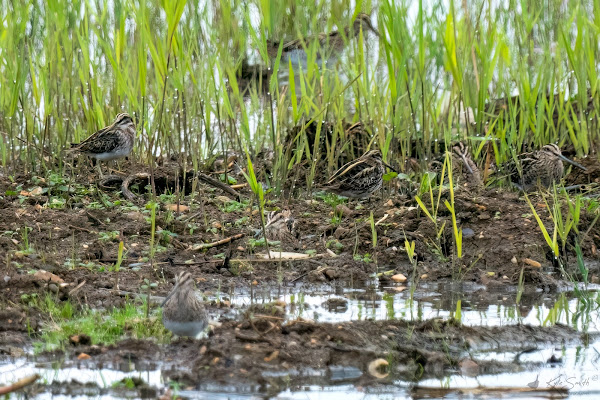Kev @kev07713 would probably have liked to head up to Spurn and Flamborough given the fall of birds this week, but I had to be in Banbury by about 5.30pm as I was going out with friends for a Bonfire and Fireworks display. We saved a couple of hours by visiting RSPB Titchwell, Norfolk and hoped to be able to see something on the sea (little auk spotted along the coast on Friday) and/or Pallas's & yellow-browed warbler both reported on Friday too.
On arrival we went straight out to the beach and found it wasn't windy, or particularly cold. There were numbers of waders on the beach including two bar-tailed godwits, lots of sandering, oystercatchers, black-tailed godwits, a few dunlins, and a handful of turnstones. However we were more interested to find what was on the water.
Immediately we could see two red-throated divers and a large flock of common scoters, the scoters being too far offshore for a photograph. A dark diver was followed by Kev but he was unable to get a good enough view for a positive ID which he was disappointed with as a black-throated diver had been reported earlier in the morning but had drifted off left. Great crested grebe and razorbill appeared in singles.
We bumped into a couple who had been fortunate the day before to see a little auk splashing about in the shallows just along the coast – we wouldn’t be so lucky.
Brent geese added to the flocks of wigeon moving along and in from the sea. We were keeping an eye on reports and saw that the yellow-browed warbler had been reported by Fen Hide - the weather was drawing in with mist rolling in off the sea – looking very grey. A call went up and we watched as a merlin cut through sending waders into the sky as it passed.
We made our way back to the Visitor Centre passing grey plover, curlews, and stonechats on the way. Avocets and black-tailed godwits took to the air but there was no sign of any adversary – the merlin?
We came across a group of people searching for a warbler and I joined them. Kev wandered off and in a few minutes I got a call to say that a women he'd come across had called a hawfinch on the ground, near the car park and toilets. By the time I got there the bird had come off the ground and disappeared into the bushes but a few minutes later Kev scanned further down the path with his scope and found the bird feeding by a gate. This wasn't a bird we were expecting to see today. As news broke dozens of people rocked up and we decided to depart.
We searched for a while around the picnic area and in the general vicinity of the Centre and, despite seeing a bird foraging in the ivy which didn't appear to be a goldcrest, we were unable to make a positive ID before it was lost. We decided to stop for lunch and managed to get a spot at the last remaining outdoor table, drying off the seats.
We returned to the task of searching for a warbler and stalked along the boardwalk to the Fen Hide and beyond. Unfortunately, there wasn't a sniff of our bird but we had encounters with flocks of goldfinches, tits and treecreeper. A noisy jay landed in a nearby tree and strutted his stuff before also flying off in search of food.
To be honest, the number of small bird species was fewer here than back around the Visitor's Centre, but we persisted for a while before heading back to the picnic area and on the other side of the hedge from the Fen Hide, and around the overflow car park. Another unknown species flew about 15ft off the ground at the rear of the Centre but didn't stop to allow a view. Time was getting on and aware that we'd need to be leaving before mid-afternoon we decided to make our way back along the main trail towards the sea. We stopped to look down a channel and picked out a handful of bearded tits cutting across, back and forth; they were never close enough or predictable enough to even try for a photo. Behind us flew a kingfisher and behind that, perched on a tall post was a kestrel, now bathed in sunshine. Overhead flew flocks of mainly barnacle geese but also a few pink-footed geese.
There were handfuls of redshanks feeding on the marsh and they took flight with many other waders when a marsh harrier flew through. A flock of hundreds if not thousands of golden plovers joined those circling in the sky.
Eventually it was time to make tracks and despite finding a chiffchaff (raised our hopes briefly), more goldcrests and treecreepers we just couldn't locate a yellow-browed warbler - but talking to others, neither could they. After we’d left a yellow-browed warbler was reported around the Visitor’s Centre and the day after that there were two. Elusive. Hopefully I will get to see one before the autumn is out.
By the time I left home for the night's Bonfire and Fireworks display the heavens had opened and the roads became waterways. Despite arriving on time, we decided to give standing in the pouring rain a miss and enjoyed the fireworks, at least the sound, from our friend's house.























































